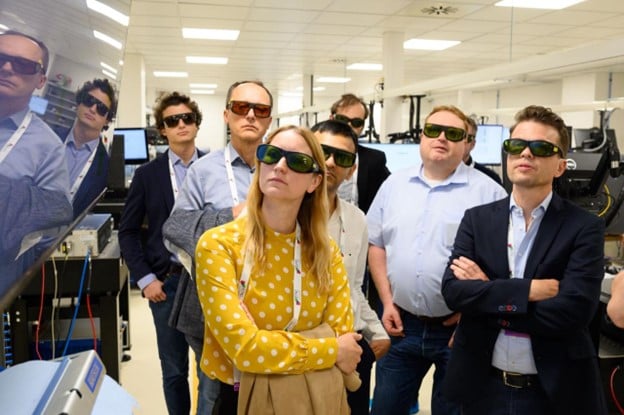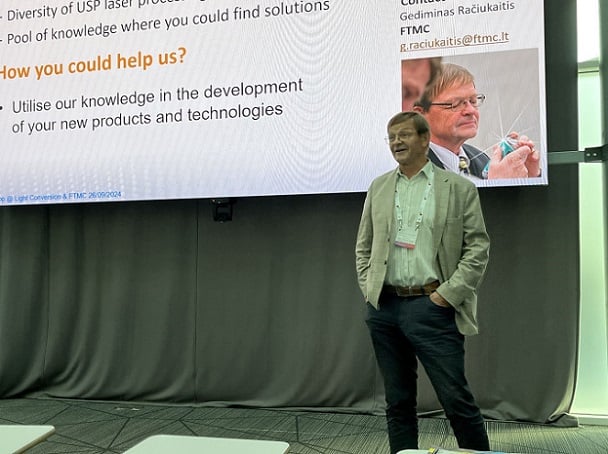Full company details
OPTOMAN
 Ukmerges St. 427
Ukmerges St. 427
LT-14185 Vilnius
Lithuania
About Lasers and a Dinosaur
Photonics.com
Oct 2024In September, the European Photonics Industry Consortium (EPIC) hosted its Technology Meeting on Laser Microprocessing in Vilnius, Lithuania. The atmosphere was intense with effective networking and a steep learning curve for attendees about new trends and local companies.BY ANDREAS THOSS, CONTRIBUTING EDITOR
Lithuania is a small country, roughly twice the size of the State of Maryland, and with a population of 2.9 million. Its status as a photonics hotbed, especially in ultrashort pulsed laser technology, owes largely to the many reputable brands that headquarter in Vilnius, the nation’s capital city. Light Conversion, Standa, EKSMA, and EKSPLA are among the firms established in Vilnius over the last 40 years. Today, 60 companies and more than 2000 people working in lasers and photonics call the country home, according to Gediminas Raciukaitis, who serves as head of the Laser Department of the Center for Physical Sciences and Technology FTMC and president of the Lithuania Laser Association in Vilnius.
On the industry side, Light Conversion is Lithuania’s largest laser maker. The company develops and manufactures ultrashort pulsed lasers, employs 600 people, and has earned more than €100 million in annual sales revenues. Today, more than 7500 of its laser systems are active in the field.

Four company visits and 20 presentations highlighted the proceedings of the 2024 EPIC Technology Meeting on Laser Microprocessing. The meeting was held in Vilnius, Lithuania, Sept. 25-26. Courtesy of EPIC.
Light Conversion hosted the late-September technology meeting, and company CEO Martynas Barkauskas personally led participants on a tour of the company’s state-of-the-art facility. Light Conversion moved into a new building in 2021, and today space is nearly full following years of double-digit growth.
How a dinosaur serves Vilnius’ laser community
Lithuania’s academic foundation is a well know success story. The first laser built here was completed in 1966. The method of optical parametric chirped-pulse amplification was invented by a Vilnius University research group and represented a major advancement in improving the amplification of ultrashort pulses. It is without saying that Lithuania, and Vilnius in particular, has always been home to many physics and laser students.
This does not nearly explain its long-term engagement and commercial success. Germany is only one hour from Vilnius, and the U.S. is tempting. So why do students stay and build a robust local laser industry?
I posed this question to Gediminas Raciukaitis, who smiled and told me the story of FiDi, the dinosaur.
“In 1978, some physics students had the idea to build a dinosaur — a large one, with a car inside,” Raciukaitis said. “On the Day of Physics in April, they moved it within a great procession of several kilometers through the whole city of Vilnius to the philological department of the University. And they have done this every year since then!”
As the story goes, the builders of the original iteration of FiDi, so-named for the Lithuanian words for “physics” and “dinosaur,” likely created the dinosaur to impress romantic interests among the philology students. As one can see in a modern
YouTube video, the dinosaur stands for the fabulous talents the physics students show when it comes to approaching a partner.
Pictures from FiDi55, the 2024 incarnation, show a huge procession of students, professors, and families, with a new FiDi as it was built every year over the course of more than 50 years.
Building a dinosaur is an activity that goes beyond learning formulae. It has shaped generations of physics students in Vilnius. During the months of preparation, participants not only learn team skills, but also make friends for life. And this is where the Lithuanian laser elite is formed as a team. Just look at your local photonics students and think how such an annual project would build spirit.
And these teams extend beyond academia. When Lithuanian graduates go for an interview with a company in Vilnius, they may find themselves facing their buddy from the FiDi parade a few years ago. At the very least, the CEO they are talking to is likely to be a Lithuanian who has followed the same career path and knows exactly what to expect.
As the most prominent example, Martynas Barkauskas himself studied in Vilnius and started as a post-doc at Light Conversion before moving into the service department, learning about customer needs and technical problems. Today as CEO, he enjoys close connections to local professors, competitors, and new entrepreneurs. And of course, he has built a dinosaur.
What’s hot and cooking
EPIC is an industry consortium, and so its Technology Meeting presentations are unrelated to academic achievements and instead focused on technological progress in industry. The main theme of the EPIC Technology Meeting on Laser Microprocessing was industrial applications of ultrashort pulses. Texturing large surfaces has become a hot topic. Lasers (including with GHz bursts) as well as scanners, software, beam shaping mechanisms, and UV pulses each took the spotlight. Drilling glass with bottom-up approach, in which the beam from the top starts drilling from the bottom, moving upward, was mentioned repeatedly. Multi-beam systems and fringe-based processing were also the focus of many discussions. One guest asked about the potential for an application to emerge requiring development of a deep-UV scanner (just one more hen-and-egg discussion).
There were also new ideas presented, such as laser dicing of semiconductors through a liquid. Germany-based startup Lidrotec offers machines that perform this function. A layer of a flowing liquid on the surface allows clean and dust-free dicing of materials such as silicon carbide, said Lidrotec’s developer of business development and sales, Christian Keil. The liquid is (obviously) transparent, non-poisonous, and has a low viscosity.
Andreas Russ came from the other end of the scale: At Robert Bosch Manufacturing Solutions, Russ is group leader for laser technology for special machines. His team provides the automotive industry with complete solutions for various laser processes. This includes system engineering, machine construction, and process development. The machines that Russ’ unit delivers must be fully networked and optimized for 24/7 operation with minimum downtime. This means, for example, monitoring both the laser and the process, as well as storing all data for traceability. Russ shared application examples that ranged from diesel injection nozzles to surface polishing of silicon wafers. The challenges — managing machines around the world in different climates and with different levels of operator expertise — are considerable. Russ’ presentation was a journey into the world of big industry, and the audience followed with great excitement.
Going out to companies
EPIC Technology Meetings have a strong bias to networking. "People come here to synchronize," said Tim Kunze, CEO and co-founder of Fusion Bionic, a solution provider for laser-based surface functionalization. "They promote their offers or find a partner whose services they need."
Often, this happens during one of the frequent coffee breaks or over dinner. And the company visits themselves are also excellent for this purpose: Even the bus trips can develop into a one-to-one pitch, if you know how to make it.

Gediminas Raciukaitis, head of the Laser Department of the Center for Physical Sciences and Technology FTMC and president of the Lithuania Laser Association in Vilnius, leads a session at the EPIC Technology Meeting on Laser Microprocessing. Courtesy of Andreas Thoss.
EPIC facilitated four company visits in Vilnius. Following the tour of Light Conversion, a visit to industrial laser maker EKSPLA provided an answer to another major question: What is the difference between the two local brands EKSMA and EKSPLA? EKSMA, it turns out, stands for “for “experimental machines” while EKSPLA stands for “experimental lasers.”
Also on the itinerary was Workshop of Photonics. A site visit to the company provided insights into its Bessel-beam based technology for in-glass processing of microfluidic structures.
Remigius Šliupas, CEO and co-founder of Optoman, shared interesting details about the company’s market reach. Of the 300,000 optical coatings that Optoman sells each year, 19% go to the local industry, 37% are sold in Germany, and only 5% are sold in America. Like most companies, Optoman runs its machines 24/7. Labor shortages are an issue, which Šliupas takes as a motivation to push automation.
What to take home
EPIC meetings are intense networking events. Two days feel like five, and Vilnius was no different, with two dinners, 20 presentations, four company visits, and many hours of networking. The main takeaway: The local laser industry is thriving.
The last EPIC meeting on micromachining in Vilnius was nine years ago, and Martynas Barkauskas, CEO of the largest local sponsor, suggested that it be repeated at least every four years. With around 60 participants, it was a comfortable gathering for 2024, and the full length of supply chain was represented.
And as with so many EPIC meetings, participants took home serious business contacts.
[email protected].